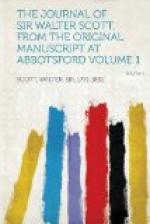[244] For the life led by many of the detenus in France before 1814, and for anecdotes regarding Sir Alexander Don, see Sir James Campbell of Ardkinglas’ Memoirs, 2 vols. 8vo, London 1832, vol. ii. chaps. 7 and 8.
[245] Hugh Scott of Harden, afterwards (in 1835) Lord Polwarth—succeeded by his son Henry, in 1841.
[246] Henry Jas. Scott, who succeeded to the Barony of Montagu on the demise of his grandfather, the Duke of Montagu, was the son of Henry, 3d Duke of Buccleuch. At Lord M.’s death in 1845 the Barony of Montagu expired.
[247] Henry Scott, afterwards Lord Polwarth.
[248] Slightly altered from Pope’s Eloisa to Abelard.
[249] The Catalogue of Criminals brought before the Circuit Courts at one time was termed in Scotland the Portuous Roll. The name appears to have been derived from the practice in early times of delivering to the judges lists of Criminals for Trials in Portu, or in the gateway as they entered the various towns on their circuit ayres.—Chambers’s Book of Scotland, p. 310.
Jamieson suggests that the word may have come from “Porteous” as originally applied to a Breviary, or portable book of prayers, which might easily be transferred to a portable roll of indictments.
[250] Quarterly Review, No. 66, Pepys’ Diary.
[251] Twelfth Night, Act II. Sc. 3.
[252] See Froissart’s account of the Battle of Crecy, Bk. i. cap. 129.
[253] Merry Wives of Windsor, Act iv. Sc. 1.
[254] See Goldsmith’s Comedy, Act III.
[255] King Lear, Act III. Sc. 2.
[256] James Pringle, Convener of Selkirkshire for more than half a century. For an account of the Pringles of Torwoodlee, see Mr. Craig Brown’s History of Selkirkshire, vol. i. pp. 459-470.
[257] “The Insurrection of the Papers—a Dream.” The Twopenny Post-Bag, 12mo, London, 1812.
[258] The well-known ballads on these two North-country legends were published by M.G. Lewis and Mr. Lambe, of Norham. “Sir Guy,” in the Tales of Wonder, and “The Worm,” in Ritson’s Northumberland Garland.—See Child’s English and Scottish Ballads, 8 vols. 12mo, Boston, 1857, vol. i. p. 386.
[259] Fyn Segellak wel brand en vast houd: old brand used by sealing-wax makers.
[260] Balaam is the cant name in a Newspaper Office for asinine paragraphs, about monstrous productions of Nature and the like, kept standing in type to be used whenever the real news of the day leaves an awkward space that must be filled up somehow.—J.G.L.




